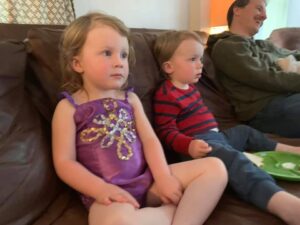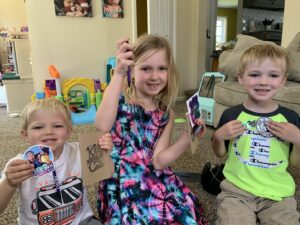The Benefits of Co-Viewing Media with Children..
The Benefits of Co-Viewing Media with Children: A Deeper Understanding Through Shared Screen Time
 The modern world of media is rapidly changing and what – and how – we watch and consume content is evolving. Children and adults are consuming images, videos, and music at rapid rates. Most of it moves so fast it is hard to fully catch and comprehend the message, the moral, or even the details of the story. Parents and educators are constantly seeking fresh, safe, and educational content for our children and previewing and co-viewing help us make informed decisions about it. As a daddio, I want to know what kind of messaging is being communicated to my kids. What are the takeaways? Was there something new to them that we should discuss?
The modern world of media is rapidly changing and what – and how – we watch and consume content is evolving. Children and adults are consuming images, videos, and music at rapid rates. Most of it moves so fast it is hard to fully catch and comprehend the message, the moral, or even the details of the story. Parents and educators are constantly seeking fresh, safe, and educational content for our children and previewing and co-viewing help us make informed decisions about it. As a daddio, I want to know what kind of messaging is being communicated to my kids. What are the takeaways? Was there something new to them that we should discuss?
In our home, when we’re able to watch videos with our children we often hit the pause button to answer questions (lots of questions!), and discuss scenarios, meanings and behavior. We parents get an understanding of the series, characters and themes and are able to assess the series. Is it safe, encouraging, respectful, motivating, value-based, and overall acceptable? Is it too edgy or promoting problematic behaviors?
When we set out to create our children’s series: Cap’n Ben and the Magic Ship, making a family-friendly show was one of our priorities. We hoped to make something that families, educators, and caretakers could view alongside their kids and even enjoy themselves! So where’s the math behind this co-viewing idea? Does co-viewing help in children’s development, particularly, for those between ages 4-8? Yes! Co-viewing and discussing media, also known as Active Mediation, can further the development of children. Here are a few benefits of co-viewing children’s entertainment.
Media Literacy and Responsibility
With media seemingly everywhere and growing, co-viewing provides an opportunity for children to learn how to use (or not use!) media in responsible ways1. Healthy limits of time and attention given to media, our attitudes regarding it and our attitudes to others while we’re consuming it are ways we can model positive use of media to our kids2. We have an opportunity to exemplify self-regulation when turning off the screen when someone needs our attention, or to shift gears and engage in more interactive activities like creative play, exercise, talking, singing, or reading3.
Positive Behavioral Effects and Reduced Aggression
Narrative media and entertainment often include conflict and/or aggressive behaviors and co-viewing helps interpret these matters4. Active parental commentary, interpretation and mediation have been found to improve children’s social behaviors, build conflict resolution skills and reduce aggressive behavior compared to watching alone. One article presents the “Springboard Technique” in which the media can “organically” present a neutral setting to discuss sensitive issues in a safe place5.
Improved Problem-Solving Skills
Active parental mediation has been found to effectively improve critical thinking skills and social development. Children can deeper understand problem solving processes when they can ask questions about character’s actions6.
Encouraging Life Skills and Character Growth

The American Academy of Pediatrics recommends families co-view media as a way of discussing family values7.
Vocabulary in Real World Scenarios
People worldwide have used the sitcom Friends to learn the English language because it “combines easy-to-understand English in real life scenarios8.” Similarly, children learn from media that presents new vocabulary explicitly (words defined) as well as in the context of real-life scenarios, conversation and story. The National Literacy Trust reports research that co-viewing9:
- Has a positive correlation between language development and viewing quality children’s educational programming.
- Improves receptive and expressive vocabulary, use and understanding of complex sentences, pronunciation, emphasis and varied situational meanings.
- Improves oral ability and comprehension of new meanings.
*It is worth noting that watching non-age appropriate media (adult/commercial, or overly stimulating) media, especially viewed alone, can hinder language development of children.
Safe Content Consumption and Curation
Co-viewing helps caregivers monitor, assess, and filter the content to ensure it is high quality and age-appropriate, leading to increased comprehension and application of concepts10.
But How Do We Do It?
The American Academy of Pediatrics published the TECH parenting model for effective media management11. It stands for:
Talking to your kids about media use.
Educating your children about media-related risks.
Co-viewing and co-using media actively with your kids
(Setting) House rules for media usage.
A Co-Viewing Game
One study presented a fun spin on co-viewing to stretch the creativity muscles12. You can mute the video and ask the students what the characters could be saying. You can also pause the video, or end the viewing session with an open-ended, “What do you think will happen next?” and gather some ideas and then discuss them after resuming the series/video. This helps motivate attention to context, comprehension, and critical thinking skills! Booyah!
You can see there are many benefits when parents and educators watch TV or videos together with their children. We have an incredible opportunity to shepherd the next generation by co-viewing media with them. Co-viewing is the legend on the map that helps them navigate this sea of media – and the benefits will compound. A larger vocabulary will boost their expressions and expand their communication. As they discuss the feelings of characters they can relate to others socially with more understanding. As they process problem-solving or conflict resolution, they will learn about sharing, fairness, and working through obstacles and challenges.

With Cap’n Ben, our heart is to create engaging media that is safe, entertaining and set at a pace for learning for kids – and pleasant for adults too (Thank you for paving the way, Mister Fred Rogers!). The videos of Cap’n Ben are infused with positive humor, character-building object lessons and magic that make learning fun and memorable.
We invite you to co-view our content with your children and pause the videos and discuss it! Help them find a lasting, deeper understanding of object lessons, vocabulary, and character values – all while strengthening your bond with them! Say goodbye to glazed eyes and “Ahoy” to actively shared experiences that incite growth, discovery and shared joy.
Join us at youtube.com/c/capnben and set sail on a voyage of discovery, growth, and fun-filled shared learning!
Thank you for reading and watching!
– Ben Beitzel
References
1 https://www.oecd.org/education/ceri/Booklet-21st-century-children.pdf
2 https://www.sciencedirect.com/science/article/abs/pii/B9780123708779001602
3 https://www.ncbi.nlm.nih.gov/pmc/articles/PMC2862999/
4 https://www.sciencedirect.com/science/article/abs/pii/B9780123739858000325
5 https://files.eric.ed.gov/fulltext/ED231328.pdf
6 https://journal.psych.ac.cn/xlkxjz/EN/10.3724/SP.J.1042.2016.01290
7 https://www.sciencedirect.com/science/article/abs/pii/B978012809481500016X
8 https://www.nytimes.com/2021/05/29/arts/television/friends-reunion-english.html
9 http://cdn-literacytrust-production.s3.amazonaws.com/media/documents/2004_04_01_free_research_-_television_and_early_language_development_review_DXQ8Gw1.pdf
10 https://jamanetwork.com/journals/jamapediatrics/fullarticle/2762864
11 AAP, Vol 142. Issue 1. 7/2018, Accessed 5/30/23
12 https://files.eric.ed.gov/fulltext/ED231328.pdf
13 https://www.ncbi.nlm.nih.gov/pmc/articles/PMC5823000/
14 https://files.eric.ed.gov/fulltext/ED231328.pdf

